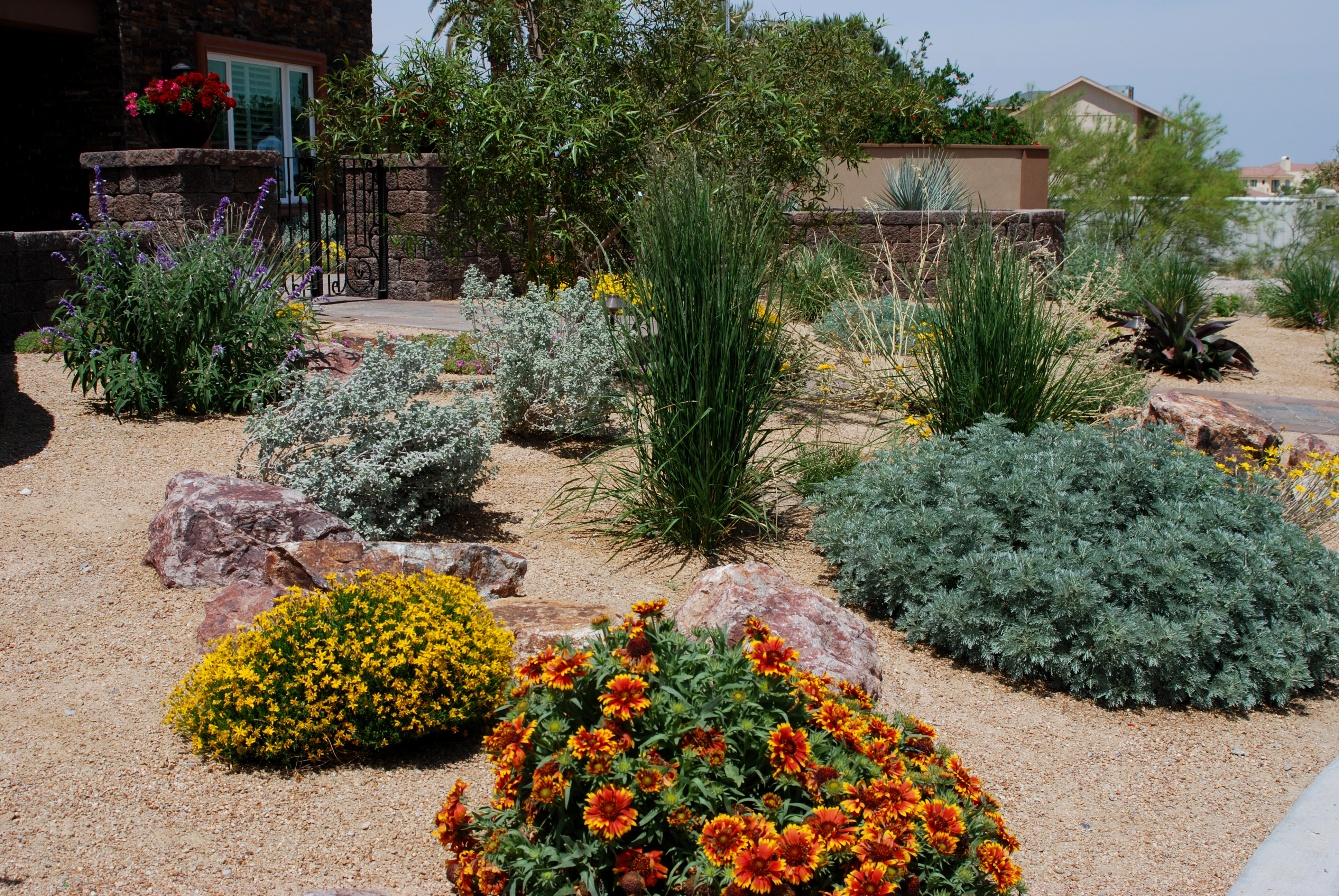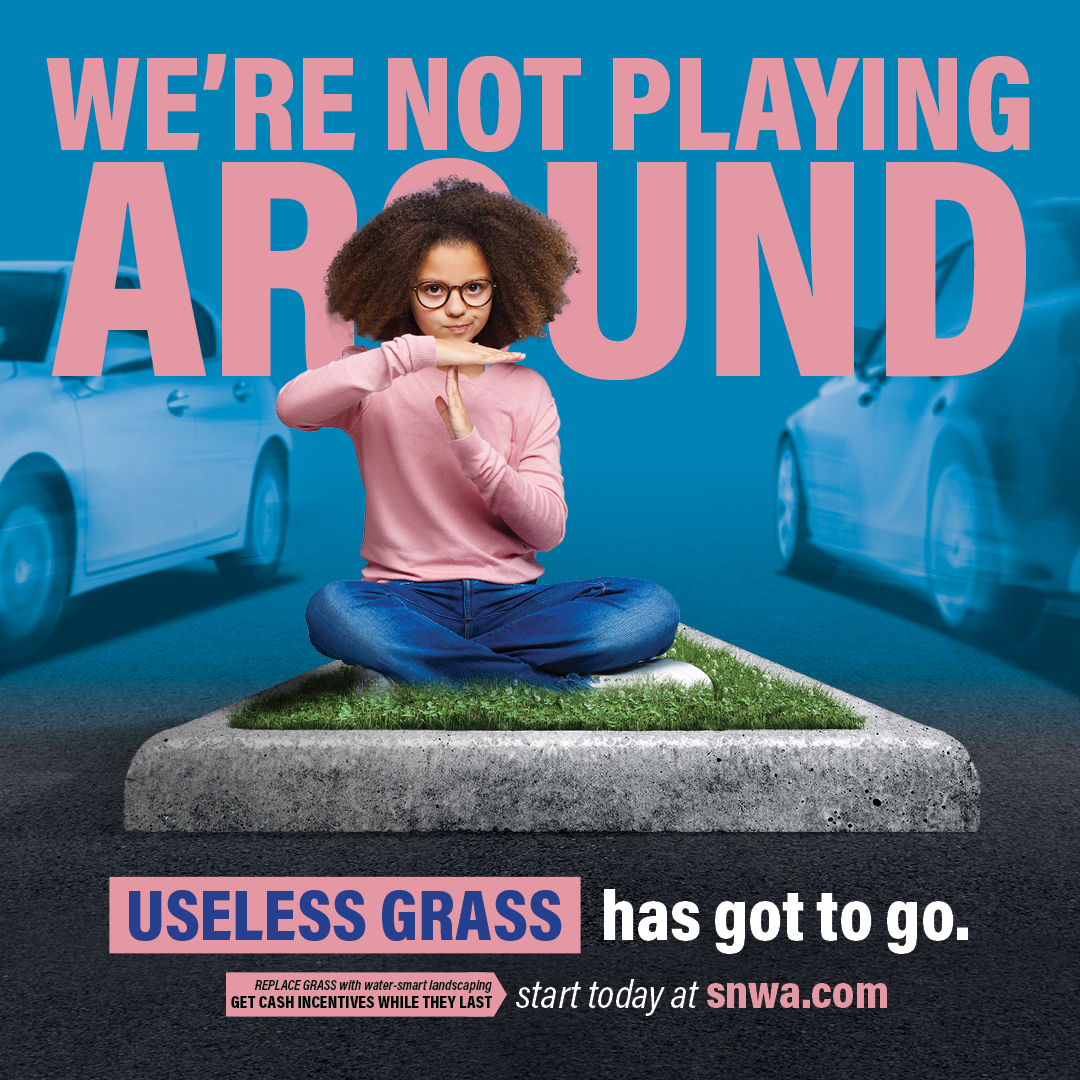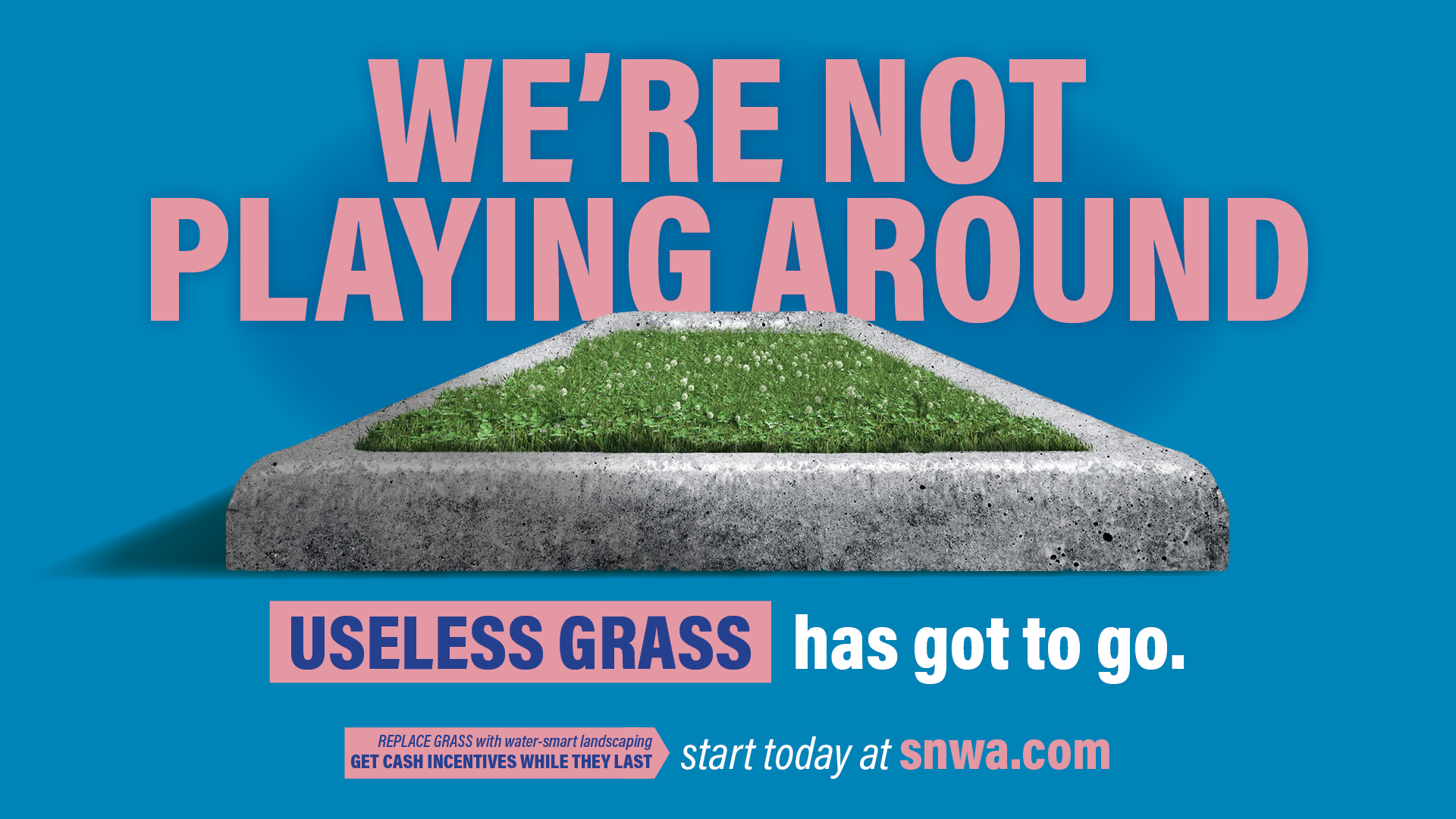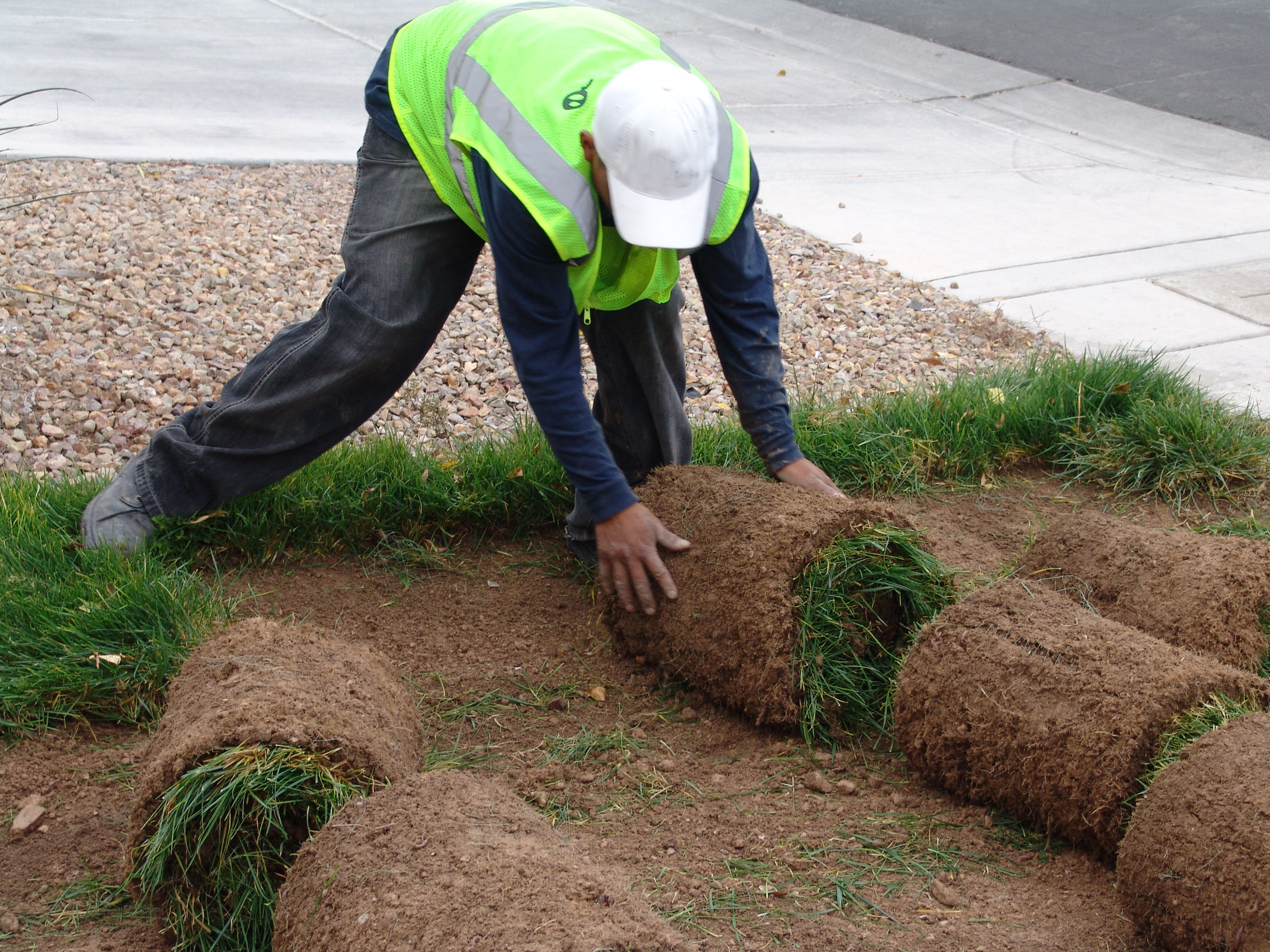Southern Nevada Water Authority's Water Smart Landscapes Program
As climate change leads to more drought situations, it will be important to understand how to best promote water conservation. Southern Nevada Water Authority’s Water Smart Landscapes (WSL) program pays homeowners to replace their non-native, ornamental lawns with plants and landscapes that use less water because they are better adapted to their dry climate. It is one of the longest running “cash for grass” policies. Designated a Landmark case study by our climate change peer review panel in 2022.
Background
Outdoor water use can represent up to 65% of customer demand in arid areas, and consumers are seldom aware of how much water is used outside, indicating that it could be “low-hanging fruit” for water conservation in dry regions. For example, in Las Vegas a square foot of grass uses about 73 gallons of water every year, whereas a square foot of native plants and landscaping can cut that to 18 gallons or less. In addition, Southern Nevada utilizes Return Flow Credits for water used from the Colorado River. For every gallon that Southern Nevada pulls from the Colorado River, it can be used and then, when treated and returned to the river, SNWA gets a credit. Outdoor water use is consumptive; that water is used once and cannot be sent back to the river. Water used indoors is non-consumptive and can be treated and returned to the river for community reuse, thus extending already limited water supplies. As a result, Southern Nevada must minimize the water lost through consumptive means.
Getting Informed
Over the course of time, SNWA learned from WSL participants the types of incentives that worked best for them. WSL started in 1996 as a research study and was subsequently rolled out to all property types in Southern Nevada in 1998 as a program. In its initial phase, the program offered bill credits based on the amount of water conserved (rather than the size of the landscape converted), but this proved hard to measure and confusing to homeowners. In July 2000, this was changed to a one-time credit on the water bill based on the area converted - $4.30/m2 (40 cents /ft2) up to $1000.) As drought concerns increased in 2003, the rebate and maximum total subsidy were increased and SNWA started giving checks to participating customers, instead of credits on subsequent water bills.
Targeting the Audience
The program focused on property owners in Southern Nevada municipalities, including the Cities of Las Vegas, North Las Vegas and Henderson, unincorporated Clark County and the town of Laughlin (Big Bend Water District).
Delivering the Program
Note: To minimize site maintenance costs, all case studies on this site are written in the past tense, even if they are ongoing as is the case with this particular program.
Each program applicant first received a site visit to verify that the property met minimum conversion requirements and that the turf was alive and irrigated. Once approved, the owner could replace the lawn with low-water plants (xeric landscaping) or artificial turf. Turf could not be replaced by impermeable surfaces, and the converted areas had to contain at least 50% living plants at maturity. A final site visit confirmed that the conversion was suitable and met program requirements. Then the owner received payment of the incentive. (Financial Incentives)
Before and After Conversion at Cambridge Quail Office Building
.jpg)
.jpg)
Courtesy of the Southern Nevada Water Authority (snwa.com)
Fine-Tuning the Incentive
Between January 2003 and December 2006 payments were $10.76/m2 ($1/ ft2) up to a limit of $300,000 per single property. Then, throughout 2007 there was no limit, and the first 139 m2 of turf removed was subsidized at twice the standard rate. In January 2008, the rate structure was again revised – this time to a flat $16.15/m2 rebate with no upper limit. Starting in November 2008, a tiered structure was re-introduced, with the $16.15/m2 rebate applying to only the first 465 m2 of converted landscape, and a rate of $10.76/m2 for additional space converted, and an upper limit of $300,000. As of 2022, the rebate was $32.28/m2 ($3/ft2) with an upper limit of $300,000.
The rebates covered about two-thirds of an owner’s out-of-pocket conversion costs before 2007, and most if not all of the costs thereafter.
Home with Desert-Adapted Plants
 Courtesy of the Southern Nevada Water Authority (snwa.com)
Courtesy of the Southern Nevada Water Authority (snwa.com)
Promotion
The incentive was promoted through the local media (news releases), advertising (radio, television, print and digital), snwa.com and lvvwd.com, bill inserts and direct mail, community events, social media, conservation classes, a Speakers’ Bureau, presentations and through the communications of the Southern Nevada Water Authority’s member agencies. (Mass Media)
As the following posters illustrate, some of the promotion focused on conversion being the right thing to do, not just a way to save money. (Norm Appeals)
Promotional Poster

 Courtesy of the Southern Nevada Water Authority (snwa.com)
Courtesy of the Southern Nevada Water Authority (snwa.com)
Time to Convert
While the average time between application and completion was 163 days, 4.3% of conversions took more than a year.
Persistence
At first there was no requirement for how long owners were required to maintain the conversion. In February 2003, this time frame was set at five years. In March 2004, it was increased to 10 years or sale of the home. Since June 2009, the program required that the xeric landscape be maintained in perpetuity, even after the property was sold. In 2009, a Conservation Easement was recorded against a property receiving the rebate and this easement remains on the property – regardless of ownership.
Removal of Non-Functional Grass
In Southern Nevada, there was an ongoing debate about how grass was used – trying to determine what was functional (for recreation, for example) versus what was non-functional (i.e., ornamental and aesthetic.) In March 2021, Nevada legislators, with the SNWA’s support, passed a law requiring that any grass watered with Colorado River water and deemed non-functional, had to be removed by January 1, 2027. This included decorative grass in parking lots, medians, streetscapes and other areas where it was used for aesthetics and not recreational purposes. The law applied to commercial properties, homeowners’ associations and multifamily developments and was expected to save 10% of the community’s water supply. The WSL program inspired similar efforts to remove and prohibit non-functional, predominantly ornamental, grass throughout the Colorado River Basin.
Landscaper Removing Grass
 Courtesy of the Southern Nevada Water Authority (snwa.com)
Courtesy of the Southern Nevada Water Authority (snwa.com)
Overcoming Barriers
|
Barrier
|
How it was addressed
|
|
No strong reason to switch to low-water plants
|
SNWA continually evaluated the cost to complete conversions through past work by landscapers. In addition, an evaluation was made for the cost of water. Using variables such as these, rebate amounts were determined that would be attractive to property owners.
|
|
Low awareness of potential benefits of switching to low-water plants
|
Early research showed that customers did not know where to go for a conversion and what conversions would look like. As a result, SNWA created the Water Smart Landscaper program to provide customers a list on snwa.com of licensed landscapers educated about SNWA programs.
In addition, several design brochures were created and a plant database was published on SNWA.com, providing customers with information on the aesthetics and characteristics of plants and various options for desert landscape designs.
|
|
No strong reason to maintain low-water landscape year after year
|
Maintaining living grass requires more water and more maintenance than desert landscaping. Early surveys showed that customers were motivated to participate in the program, almost equally, by lower water bills and the reduced maintenance associated with living grass.
|
Financing the Program
The WSL program was primarily funded by bonds, like other SNWA capital projects. As such, the SNWA required a Conservation Easement to be recorded against a property participating in the program and receiving a rebate for a conversion. The easement assured that the conversion was permanent. For some conversions involving entities that couldn’t have easements recorded against their properties -- government agencies, for example -- operating funds were used. Conversions on properties using groundwater were funded by the Las Vegas Valley Groundwater Management Program. Lastly, SNWA periodically obtained federal matching grants and sometimes used those funds to help pay for a portion of the conversions in the WSL program.
Measuring Achievements
First, SNWA conducted an in-depth study of homes where the landscape was discreetly sub-metered to determine application rates to turf and water efficient landscape. This provided critical data, including the savings rate of 55.8 gallons per square foot for WSL vs. turf. It also studied pre-conversion and post conversion usage. The findings from the Xeriscape Conversion Study (XCS) are available here.
Later on, Brelsford and Abbott used a panel difference-in-differences approach with a 16-year-long panel dataset of monthly water consumption records for 300,000 homes in Las Vegas, Nevada.
In a subsequent study, Baker estimated water savings, energy use externalities, and property value effects over a 25-year time period, using both event studies and panel fixed-effects models.
Feedback
SNWA provided regular feedback to its citizens about what they were accomplishing, as illustrated in the following video and infographic.
.jpg)
Courtesy of the Southern Nevada Water Authority (snwa.com)
Results
Individual Homes
Homes in the XCS doing landscape conversions showed an average savings of 30% in annual usage. Note that, compared to more contemporary homes, these tended to have larger lots. For an individual home, the WSL program generally reduced water consumption by 20% throughout the year, about 34% less than previous engineering estimates. These savings persisted up to a decade after the initial landscape change, because the xeriscaped landscapes generally used automated timers.
The XCS found that on average, people with at least 60% of their landscape in xeric planting saved about a third on maintenance (2.2 less hours per month) and a third on direct costs per year. These savings were an important additional consideration in the cost-benefit calculations in the XCS beyond the expected water bill reductions. While the model for this is relatively complex and lengthy, outputs for given scenarios are available on page 57 of that study. Average return on investment for the homeowner takes between 1 and 6 years with an incentive. SNWA found positive benefits as well. When the XCS was done, these equated to a benefit of $0.58 per square foot for the organization.
In addition, an average home spent about $500 less per year, previously spent on mowing, fertilization and winter overseeding. However, Baker noted that the xeriscaped landscaping might provide less shade from the sun and therefore increase a home’s use of air conditioning – resulting in an increased energy use of 3%. The results are complex as trees which occur in both grass and xeric landscaping can mediate temperature. SNWA encourages the use of trees for this reason. Again, SNWA further required enough vegetation to cover 50% of the landscape at maturity for properties in the WSL program. This was to reduce possible temperature impacts of the conversions.
Overall Impact
By 2022, property owners in the Las Vegas Valley had removed more than 18,580 m2 (200 million ft2) of turf, converting it to water-efficient landscaping. This has saved about 617 billion liters (163 billion gallons) of water since the program’s inception. In that same time span, the valley’s population grew by 49%; however, the amount of water it took from the Colorado River shrank by 26%.
Every gallon of water saved was a gallon that didn’t have to be treated and pumped from Lake Mead into the Las Vegas Valley. The energy cost to do this was about 6.6 kWh per Kgallon and was climbing as Lake Mead shrunk. SNWA estimated that it avoided more than 90 million kWhs per year of power that would otherwise be required, thanks to the WSL program. The majority of this savings was from the reduced need for pumping. As an added benefit, the SNWA avoided more than 469,000 metric pounds of CO2 emissions as well.
Brelsford and Abbott estimated that the Water Smart Landscapes program cost the water authority about $1.88/kgal of water saved, which compared favorably to alternative means of water conservation or supply augmentation.
Baker calculated that the program saved water at an annual rate of $2.65/kgal to $3.31/kgal, which was still less expensive than most alternative means of water conservation or supply augmentation. Conversion increased property values by about 1%. Net benefits were $2.35 to $2.88 /ft2 of desert landscape converted.
Contacts
Damon Hodge
Sr. Public Outreach Coordinator
Las Vegas Valley Water District
1001 S. Valley View Blvd.
Las Vegas, Nev. 89153
Phone: (702) 822-8497
Cell: (702) 271-9013
Damon.hodge@lvvwd.com
Notes
Form of the Incentive
Bill credits based on the amount of water conserved (rather than the size of the landscape converted) proved hard to measure and confusing to homeowners. This was changed to a one-time credit on the water bill based on the area converted.
Innovation
This program’s main innovation was providing incentives for converting to and maintaining low-water landscaping, rather than for other means of lowering water use. This intervention has yielded persistent savings year after year. The WSL program was one of the first programs of its kind in the nation and one of the longest running. SNWA’s simple, one-page program conditions have served as a model for many other initiatives that have come and are coming online now (see Replicability, below). By submetering distinct landscape areas, the SNWA was able to develop the per unit area data to make calculations of average savings easy and scalable. Square feet became the basis of the rebate as well, moving the organization from highly variable savings such as gallons per home to a metric useful for all situations and customer classes.
Replicability
This approach has since been replicated in other areas with hot climates. For example, the Los Angeles’ Metropolitan Water District estimated in 2015 that it was saving up to 98.4 billion liters (26 million gallons) of water each year from a similar program. Greeley, Colorado’s program, “Life after Lawn,” which launched in 2018, had replaced about 14,000 m2 (over 150,000 ft2) of turf, saving an estimated 121 million liters (32 million gallons) of water by 2022. Castle Rock Colorado’s public program, launched in 2009, reduced home water use by 7% and its non-residential properties a decade later cut water use by about 29%. Colorado is expected to develop a statewide program in 2023.
See also:
http://www.sciencedirect.com/science/article/pii/S009506962030125X
http://apnews.com/article/climate-business-colorado-lifestyle-water-use-4e4f0fdc97d65d12c9aef39c22cd8840
http://www.journals.uchicago.edu/doi/10.1086/712429
http://www.snwa.com/assets/pdf/reports-xeriscape.pdf